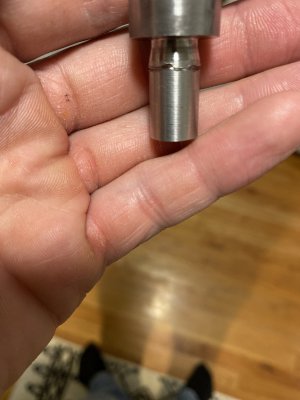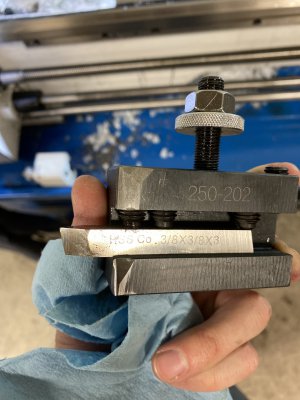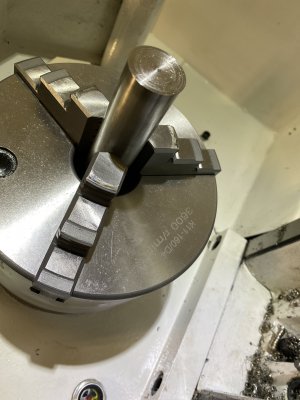@FTlatheworks
Congratulations!
It looks like your persistence got you there. Well Done.
Just a couple things:
First, as
@BladesIIB said reduce that tool hang-out for less vibration.
First some terminology. Compound = top-slide. They are the same thing.
We are using the compound (top-slide) angle adjustment to set the angle we want to feed the tool into the cut.
In this case by feeding in with the compound the tool kind of slides in at an angle rather than straight in.
This allows it to only cut on the left-hand leading edge (when feeding towards the headstock, tool at front, top of the work rotating towards you).
I find on my light and kinda loose Southbend 9" lathe this works much better than feeding straight in using the cross-slide.
When I try infeed with the cross slide the cutting forces are higher due to both side faces of the tool contacting the work-piece.
Yes absolutely we do lock the half-nuts to the lead-screw and use the lathe gearing to move the tool precisely for every rotation of the spindle.
This maybe confusion between terms again; longitudinal "carriage" feed vs. tool infeed.
The lathe will power feed the tool (indeed the entire carriage) left and right.
Our tool infeed really controls the depth of each cut. For threading we can start with larger infeeds , but as the cutting progresses the tool bit gets deeper into the work-piece and does more work, so we can relieve a little of the stress my feeding the tool bit in less.
I often start threading with 2-5 thou. infeed but it can be different for each lathe, tool bit and work-piece material.
I might try up to 10 thou. to start if I know the tools and material.
Threading often ends at 1 thou. infeed when you are getting close to final size.
Then one or two "spring passes" are done with no additional infeed. This helps to clean up the threads.
In normal outside diameter turning we usually infeed with the cross-slide....but here too you could use the compound set an an angle for infeed. Just beware that the numbers on the cross-slide dial will no longer indicate the true infeed. But it can be calculated using trig and the angle of the compound. This is sometimes used when you want very fine infeeds, like when trying to remove sub-thou. of material with a shear tool.
For threading either the compound (top-slide) or cross slide can be used for infeed.
I just find the cross-slide gives me better results on my lathe.
I'd recommend that as you get more comfortable with single-point threading you give both a try and see what works best for you.
-brino




